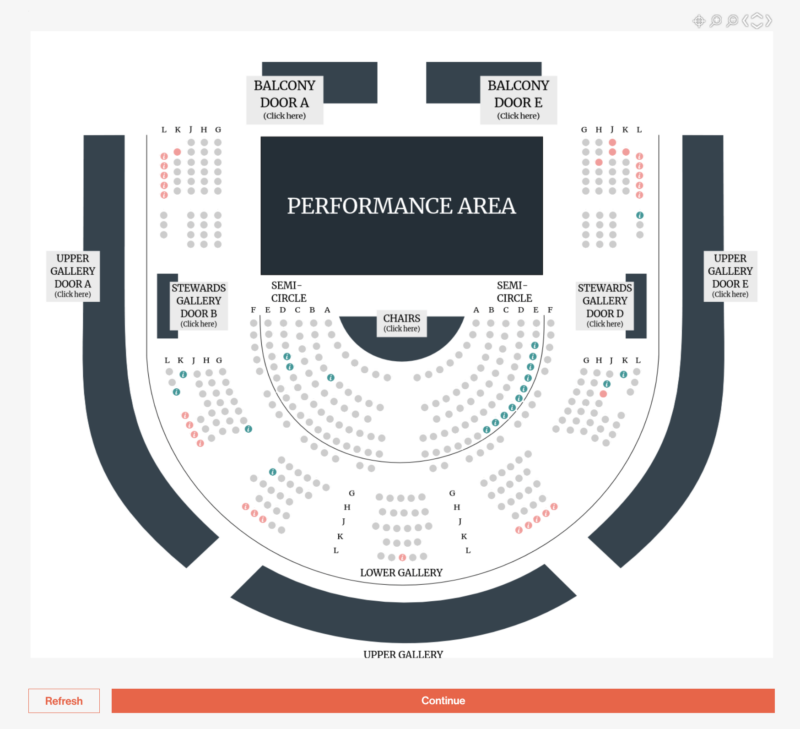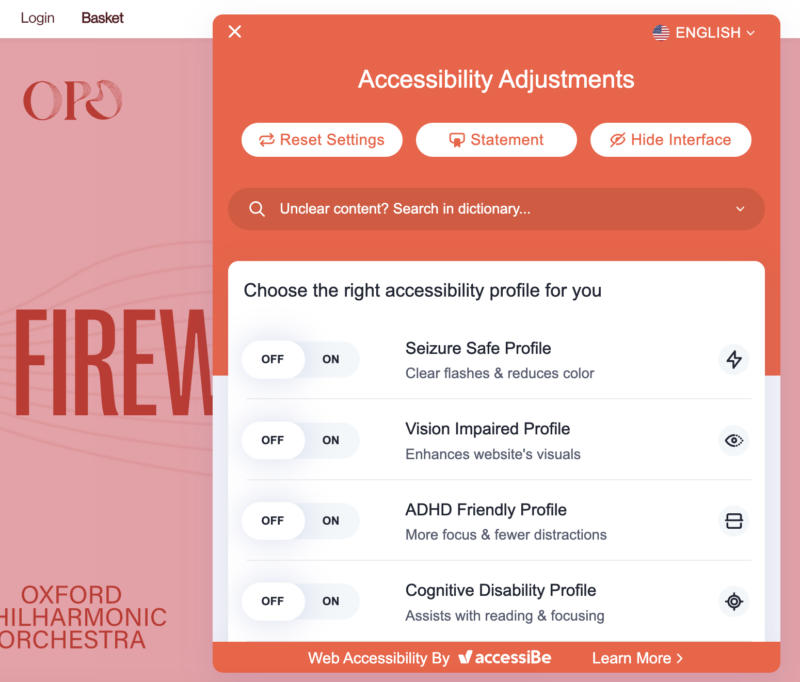“That’s the magic of art and the magic of theatre: it has the power to transform an audience, an individual, or en masse, to transform them and give them an epiphanal experience that changes their life, opens their hearts and their minds and the way they think.” Brian Stokes Mitchell.
So why would you settle for less with your theatre’s website?
How a website makes your audience feel, should be an extension of what to expect from a performance, it should connect with them. So a strong and compelling design is a must.
But first, you’ll need to consider the content and features that will best serve the needs of your audience.
We wrote this article to inspire your thinking – so grab a cuppa and enjoy the show!
1. Homepage
The homepage is an important aspect of any website, and most Theatre websites will use the opportunity to display show information immediately, but it’s also worth considering the following:
Welcome Message/Introduction: Briefly introduce the theatre, its mission and its proposition.
Featured Content: Highlight current or upcoming shows, special events, and important announcements. Consider showcasing a range of events to appeal to different audience groups. Make it easy for your audience to access this information.
Navigation Bar: Provide easy access to all main sections of the website. There is a tendency for design to take priority over accessibility with navigation, so keep referring back to your audience and make sure you don’t compromise functionality for style.
2. Show Information
Show information often will have its own page, with content feeds populating the homepage for upcoming or ‘spotlight’ content to promote particular shows. Things to include are:
Current Productions: Details about currently running shows including showtimes, synopsis, cast, and crew with clear links to book tickets. Reviews, trailers, backstage content and leading names are big selling points and should also be highlighted on the page.
Upcoming Shows: Information on future productions.
Past Productions: Archive of previous shows with photos, reviews, and details.
3. Online Ticketing
One of the most important website features for a theatre is online ticketing. It provides a convenient and accessible way to book tickets anytime, anywhere. It streamlines the purchasing process, reducing queues and wait times at the box office. Plus, it provides valuable data on customer preferences and sales trends, aiding marketing and planning. Secure and user-friendly, online ticketing enhances the overall customer experience, boosts sales, and helps theatres manage capacity and resources more effectively. Think about the following:
Booking System: An easy-to-use online ticket purchasing system – which CRM are you using? Spektrix, Ticketsolve and Tessitura are some of the more popular. Do they integrate correctly with your website and provide a seamless user experience?
Seating Chart: An interactive seating chart to allow users to choose their preferred seats can be achieved through CRM iFrames or by utilising APIs, see an example from the Oxford Philharmonic Orchestra below of how this looks, using the Spektrix iFrame.
Pricing Information: Include clear ticket price information, including discounts or special offers. Consider the use of an accessibility access key within the seat selection theatre.

4. Events Calendar
An events calendar centralises event information, making it easy for visitors to find details about upcoming shows. A clear and updated calendar helps people plan visits and stay informed, boosting attendance by keeping the audience engaged and theatre staff organised. The calendar aids in coordination and resource management. You should consider:
Event Listings: Comprehensive calendar showing all upcoming events, shows, and special performances. This can be achieved using a WordPress plugin such as The Events Calendar, to see an example of this in action, check out our South London Theatre case study or see the example below.
Filtering Options: Ability to filter events by date, type, category or season and highlight specific events based on holidays i.e. Christmas, kids holidays etc.

5. Membership and Donations
A well-designed donation portal is a crucial feature of a theatre website. Donations are vital to the theatre’s productions, outreach programs, and day-to-day operations. Here you should also explore opportunities to upsell memberships during the checkout process.
Membership Information: Details on membership benefits and how to join.
Donation Portal: Easy and secure way to donate to the theatre.
Sponsorship Opportunities: Information on how businesses and individuals can sponsor the theatre or specific productions.
6. About Us
Some people will want to know more about the history of the theatre, its culture and its vision – the About Us page is a great place to home this information. Consider including:
History of the Theatre: Background information and historical context.
Mission Statement: The theatre’s goals, values, and mission.
Staff and Board Members: Bios and photos of key personnel.
7. News, Press, Blogs, Articles
Aside from keeping people abreast of the latest news, this can help position the theatre as a thought leader or champion for challenges facing the sector, it’s also an important means to execute a content strategy to support SEO efforts. A blog can be used for:
News Updates: Latest news and announcements.
Press Releases: Official press releases and media contact information.
A Media Gallery: Photos, videos, and media coverage of the theatre and its productions.
Behind-the-Scenes Content: Articles about the production process, interviews with cast and crew, etc.
Theatre News: Industry news, trends, insights and work in the community.
8. Contact Information
Basic but important stuff that needs to be covered.
Contact Form: Easy-to-use form for general inquiries.
Contact Details: Phone numbers, email addresses, and physical address.
Social Media Links: Links to the theatre’s social media profiles.
9. Accessibility
It’s important to incorporate accessibility throughout the UX, design, and development phases to ensure a comprehensive and user-friendly experience for all users. You’ll want to consider:
Website Accessibility: The World Wide Web Consortium (W3C) recommends following the Web Content Accessibility Guidelines (WCAG) 2.1, Level AA. Plugins like AccessiBe provide an affordable option (see below) or accessibility consultants will provide a more comprehensive review and strategy for creating an accessible website.
Accessibility Information: Details on accessibility features of the theatre and website should be easy to find.
Language Options: Multi-language support if applicable.

10. FAQs
People don’t want to have to make phone calls these days… plus from a resourcing point of view, theatre teams are small and therefore the box-office time is best spent on the phone selling tickets rather than answering FAQ-related calls.
Common Questions: Answers to frequently asked questions about tickets, shows, accessibility, and more.
11. Search Functionality
Whilst a considered user experience can negate the need for a search feature, it can be useful especially for searching archives or for information on a specific show. Consider a site search.
Site Search: Easy-to-use search bar to help users find information quickly.
12. Mobile-Friendly Design
This is more of a general point, but with over 60% of website traffic coming from mobile devices, your website must be responsive.
Responsive Layout: Ensure the website is optimised for viewing on mobile devices.
13. SEO and Analytics
An important factor often overlooked in website briefs we receive is SEO.
Search Engine Optimization (SEO): Ensure the website is optimised for search engines to increase visibility.
Analytics Integration: Track website traffic and user behaviour for insights and improvements.
14. Privacy Policy and Terms of Service
Often referred to as the boring but essential bits…
Legal Information: Clearly state the privacy policy and terms of service to ensure transparency and trust.
Curtains Down
We know each theatre website will be different, but the above features should give you a leg-up when considering your website redesign; a decent discovery and UX session will take care of the rest. We’re working with the Rose Theatre to reimagine its website design, user journey and overall experience, so if you’d like to learn more about how we can support your theatre with its website, contact us.
Join Our Community
We’re building a community within arts and culture, connecting the inspiring minds from the sector to ponder the digital opportunities and challenges upon us and share stories of digital transformation. Join our newsletter to get involved.
Photo by Kevin Schmid on Unsplash